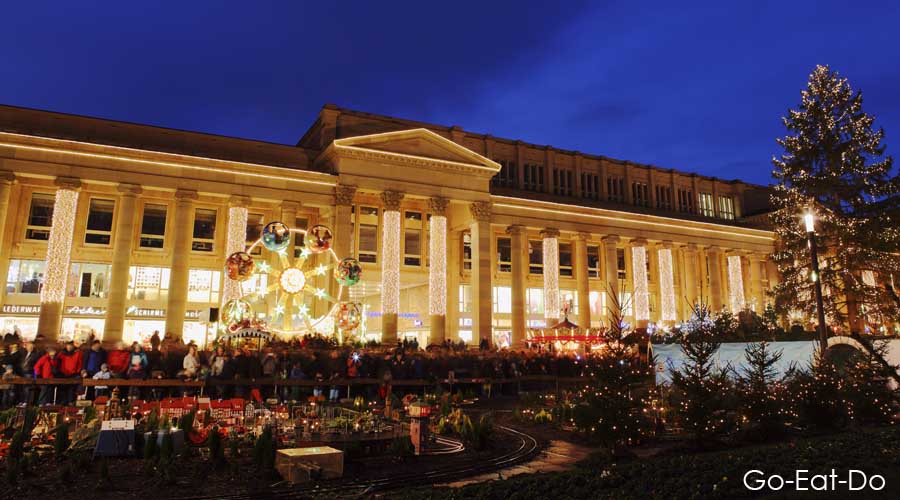Stuart Forster heads to Germany to visit the Christmas Markets in and around Stuttgart.
Atmospheric Advent markets, held on squares in towns and cities across Europe, attract millions of people in the run up to Christmas. To experience the markets I headed to Stuttgart, in south-west Germany.
Disclosure: Some of the links below, marked with a (£), are affiliate links, meaning, at no additional cost to you, I will earn a commission if you click through and make a purchase.
The markets have been held in Stuttgart for more than 300 years. The oldest document mentioning a Christmas market in Baden-Württemberg’s capital dates from 1692. That said, historians believe the tradition is significantly older.
The origins of Stuttgart’s Christmas markets
The Weihnachtsmärkte—as the markets are known in this part of Germany—started as places for locals to purchase seasonal foodstuffs, including Lebkuchen (spiced ginger bread), and to socialise. Today they also stock handcrafted gifts and decorative items, including glass baubles and wooden ornaments that can be hung from Christmas trees.
Wandering between wood huts ranged on Schlossplatz, the square marking the heart of the city, I inhaled the distinctive clove- and cinnamon- aroma of Glühwein (mulled wine) and cold, early evening air.
People wearing woolly hats stood in groups chatting, gripping steaming mugs of Glühwein. A couple of them tuck into seasonal cuisine, including Kaesekrainer—a type of grilled sausages laced with cheese and served in a bread roll with a dollop of mustard. Another offers around lightly spiced caramelised nuts from a conical paper bag.
Some aspects of the Christmas markets have changed little over the centuries. The rustic huts that house the market stalls smell of pine.

Exporting German Christmas markets
The popularity of Advent markets has seen a marked upsurge in recent years. German markets are now exported. The Frankfurt Christmas Market held in Birmingham draws around five million visitors a year. Though it’s worth seeing surely there’s something to be said for visiting one of the original markets?
Stuttgart’s Weihnachtsmarkt draws around three million visitors each year. Inhaling the urban air when it’s laced with the cinnamon scent of roasting nuts and the seasoning of grilling Bratwurst sausages helps ensure that a long-established tradition continues to breathe.
The cold might cause your nose to tingle and breathe to billow as you browse the handiwork of craftspeople who’ve made items such as multi-coloured glass candle holders, Christmas baubles crafted from pine cones and silver jewellery.
Interested in Christmas traditions? You may find the book Christmas Around the World: Christmas in Germany (£) enjoyable to read (£):

Stalls in central Stuttgart
The market’s 280 stalls stay open to 9pm every day until December 23. The evening of 24 December is when German families traditionally gather to celebrate Christmas. Consequently most people prefer not to go shopping on that day.
The huts are clustered into rows on the market square—in front of the city hall—and around Schillerplatz, the square named after Friedrich Schiller. The poet and author who was born in nearby Marbach am Neckar in 1759.
They stalls also snake along Kirchstrasse and Hirchstrasse. By the Christmas tree within the colonnaded courtyard of the Altes Schloss, Stuttgart’s Renaissance style palace, you can pause from browsing the stalls to listen to concerts featuring seasonal music.

The medieval market at Esslingen
If you’re curious about how Advent Markets might have looked during the Middle Ages head to the nearby town of Esslingen am Neckar, 15km from Stuttgart. You can see a medieval style market in operation.
More than 200 stalls are ranged along the cobbled streets and marketplace of Esslingen, whose half-timbered houses survived World War Two largely undamaged.
Jesters in colourful costumes provide entertainment on the streets, telling jokes, stories and interacting with members of the public. The jesters juggle, swallow fire and play musical instruments such as bagpipes, wind instruments similar to clarinets and drums. Crowds gather to watch their shows.
Warm mead—made from fermented honey—is served in red ceramic mugs styled like the drinking vessels used centuries ago.
During medieval times meat was a treat. Many people could rarely afford it, saving meat for feasts on holy days, the origin of the term ‘holidays’. You might see spit-roasted piglet being turned over a grill on the market place. It’s served with soured cream in warm bread over-baked with cheese.
Alternatively you might prefer to try a deie, a pizza-like dish topped with lardons and onions baked on a thin layer of cream. They are baked at a stall with iron-doored ovens. They might not be ideal if your doctor warns you about your cholesterol levels but anyone living to their mid-30s during the early 1500s was already regarded as old; the long-term effects of eating tasty food was not a concern back in medieval times.
After listening to carols and watching an evening parade to the castle, illuminated by flaming torches carried by participants, I warmed myself with a mug of Glühwein.

Getting there
Stuttgart Airport has direct connections to a number of airports in the United Kingdom and Republic or Ireland. You can fly direct from London Heathrow, Gatwick and Stansted, as well as Manchester, Birmingham, Edinburgh and Dublin.
Flights from Newcastle are available via London, Paris or Amsterdam.
Further information
Find out more about Stuttgart and Baden-Württemberg tourism information websites. For information on Christmas markets elsewhere in the country see the Germany Tourism website.
Photos illustrating this post are by Why Eye Photography.
If you enjoyed this post why not sign up for the free Go Eat Do newsletter? It’s a hassle-free way of getting links to posts on a monthly basis.
‘Like’ the Go Eat Do Facebook page to see more photos and content.





Helen Wilson
November 30, 2016 at 21:03I would love to take my mum and dad here, as my mum would love to shop here and take in the most wonderful atmosphere this magical place has, no where like it in the world.
Stuart Forster
December 4, 2016 at 10:14I hope you get to see and enjoy the markets. Have a great Christmas wherever you are.
Magda Ebert
January 9, 2018 at 16:49Traveling to meet friends at the Christmas markets is a part of seasonal life in Germany that I cherish. I like to visit a different city for the Christmas market each year.
Stuart Forster
January 9, 2018 at 17:34Thanks for sharing that, Magda.
Heidi Reynolds
January 17, 2018 at 19:59I took my two daughters to the Christmas market in Stuttgart and had an amazing time. Loved the city and its Cube art gallery!
Stuart Forster
January 18, 2018 at 18:38Thanks for sharing that.
Andy Proom
January 23, 2018 at 00:40Eating and drinking at the market was a highlight of our winter visit to Stuttgart. What a city!
Stuart Forster
January 23, 2018 at 09:29That’s positive! Socialising over food and drink is one of the key reasons why the markets are so popular in Germany.